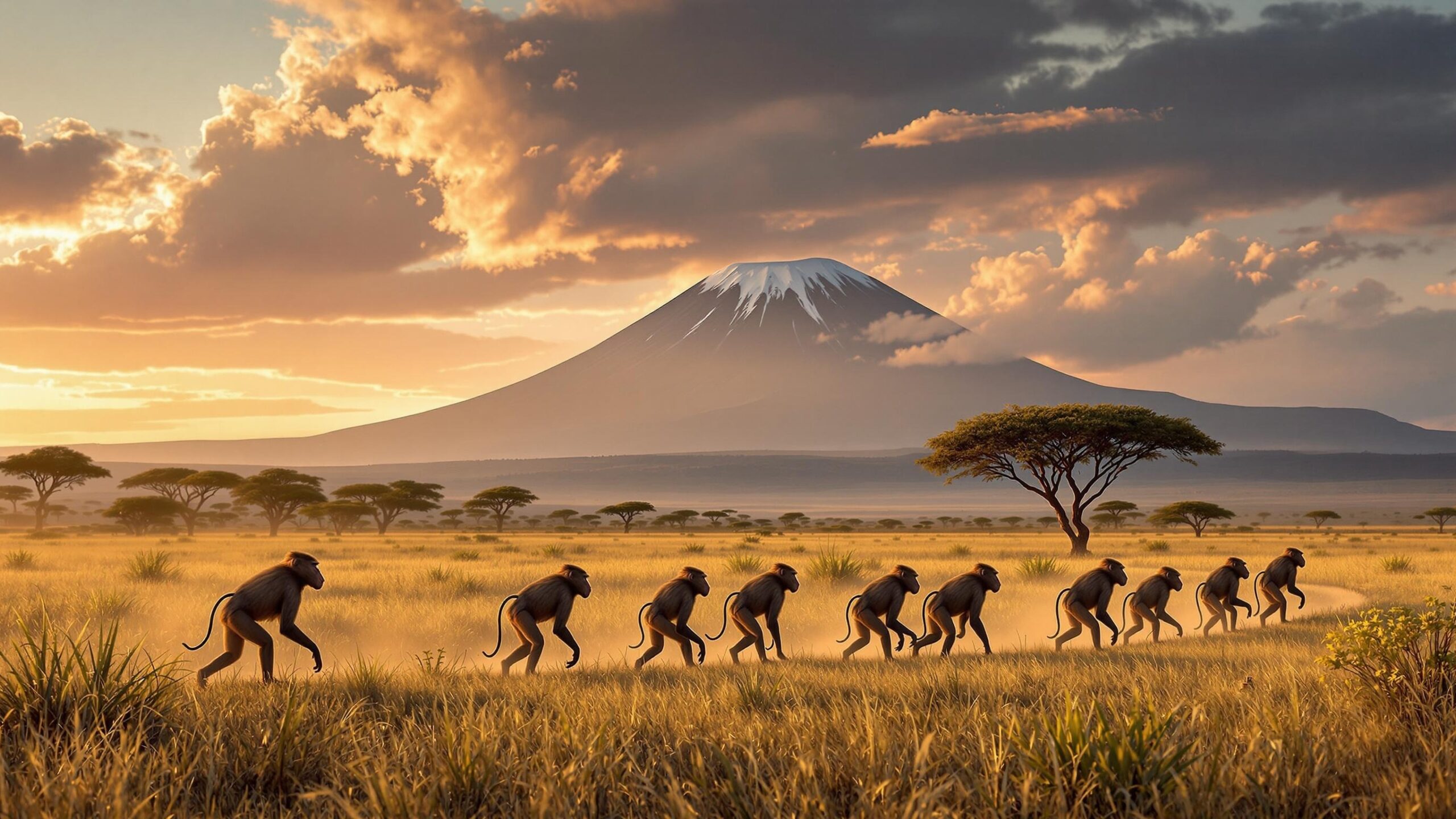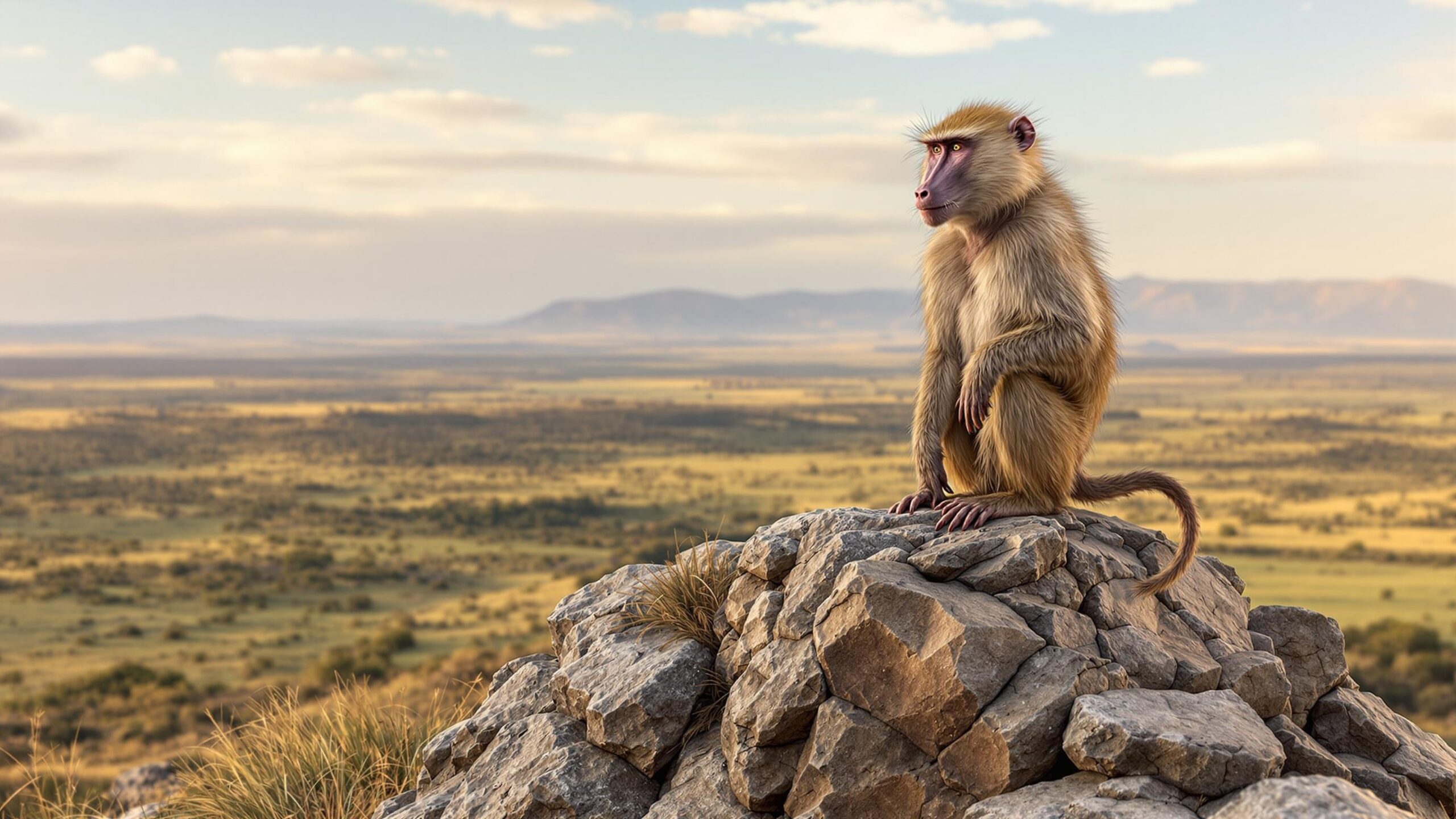Baboon: The Bold, Brainy, and Social Monkeys of Africa
Few animals embody the raw drama of the African savanna quite like the baboon. These intelligent, adaptable, and highly social primates belong to the genus Papio, and they are among the most widespread and studied monkeys in the world. Found across a diverse range of habitats in sub-Saharan Africa and parts of the Arabian Peninsula, baboons have captured the fascination of scientists, wildlife enthusiasts, and travelers alike.
More than just monkeys with dog-like faces, baboons are experts in survival. They form intricate social hierarchies, communicate with a nuanced system of vocalizations and gestures, and display behaviors that seem strikingly human—rivalries, friendships, alliances, and even mourning rituals. Their complex societies offer a window into the evolutionary underpinnings of our own social systems, making them invaluable subjects in behavioral science. In this article, we’ll dive deep into the world of baboons—exploring their biology, habitat, social structure, behavior, intelligence, and the growing need to ensure their future amid changing landscapes.
Meet the Five Species
The genus Papio includes five recognized species of baboons: the Chacma Baboon (Papio ursinus), Olive Baboon (Papio anubis), Yellow Baboon (Papio cynocephalus), Guinea Baboon (Papio papio), and the Hamadryas Baboon (Papio hamadryas). While they all share core traits—such as pronounced muzzles, large canine teeth, powerful limbs, and close social bonds—they also exhibit distinct appearances and behaviors that reflect their native environments.
Chacma baboons, the largest species, dominate southern Africa and are known for their adaptability and intelligence. The Olive Baboon, more widespread than any other, stretches from Mali to Ethiopia and down to Tanzania. The Yellow Baboon thrives in the savannas of East Africa, while the Guinea Baboon occupies a narrow range in West Africa. The most distinctive of them all, the Hamadryas Baboon, lives in arid regions of the Horn of Africa and Saudi Arabia and boasts a dramatic mane of silver-white fur around adult males.
Physical Traits: Power, Posture, and Expression
Baboons are among the largest monkeys, with males of some species weighing up to 90 pounds and measuring over 3 feet long. Their long, dog-like muzzles contain sharp teeth, including formidable canines that are especially pronounced in males. Their strong limbs and opposable thumbs make them agile climbers and dexterous foragers, capable of manipulating objects with precision.
One of their most noticeable features is the brightly colored, hairless skin on their rumps, which varies in hue from red to blue and swells in females during estrus—a signal to potential mates. While their faces are generally elongated and stern, they are capable of a surprising range of facial expressions that convey emotion, intention, and status within the group. Their coats vary by species, from the sleek gold of the Yellow Baboon to the shaggy gray of the Chacma, and the ornate silver mane of the Hamadryas male. Their fur often blends with the dry grasses and dusty soil of their habitats, offering some measure of camouflage.
Range and Habitat: From Desert to Rainforest
One of the keys to the baboon’s evolutionary success is its remarkable adaptability. Baboons occupy a vast range of environments, from arid deserts and rocky escarpments to humid rainforests and grassy plains. This geographic versatility has helped them thrive in over 25 countries, from South Africa to Egypt, and across the Arabian Peninsula.
Chacma Baboons navigate the cliffs and coastlines of southern Africa, often seen foraging in Cape Town’s suburbs. Olive Baboons prefer woodland savannas and forest edges, while Guinea Baboons are found in dense forests and gallery woodlands. The Yellow Baboon favors the open plains of East Africa, and Hamadryas Baboons occupy some of the harshest terrains, including the lava deserts of Ethiopia and Yemen. Their ability to make use of both natural and human-altered environments allows baboons to flourish near water sources, along roadsides, and even in agricultural zones—though this adaptability often brings them into conflict with people.
Diet and Foraging: Omnivorous Opportunists
Baboons are omnivores with an incredibly broad diet. Their primary food sources include fruits, grasses, roots, seeds, and leaves, but they are also known to eat insects, rodents, birds, reptiles, and even small antelopes. Their powerful jaws and molars are well-suited for grinding tough plant materials, while their sharp canines help with meat consumption and defense.
Foraging is typically a group activity, and baboons are meticulous as they move across their range, turning over rocks, peeling bark, and digging into the soil in search of food. In some areas, baboons raid crops or scavenge near human settlements, which has made them targets of retaliation. Their cheek pouches allow them to store food and consume it later in safer locations. This storage ability gives them a competitive edge, especially in areas where food is scarce or foraging is dangerous.
Social Structure: Hierarchies and Alliances
Baboons live in troops that can range from 20 to over 200 individuals, depending on the species and habitat. These troops are not mere collections of animals—they are dynamic social systems organized by complex hierarchies, familial bonds, and cooperative behaviors. In most species, males emigrate from their natal troop upon reaching sexual maturity, while females remain in the same group for life. Female baboons form matrilineal lines that influence rank and access to resources. Higher-ranking females and their offspring often enjoy better food, grooming, and protection.
Male dominance hierarchies are more fluid and typically established through displays of strength, aggression, or social alliances. In some species like the Hamadryas Baboon, males maintain harems of females and exhibit strict control over their movements. In contrast, the Olive Baboon’s social system allows for more flexible relationships, including “friendships” between males and females that may involve grooming, babysitting, and protection. Grooming plays a critical role in maintaining social bonds. It serves not only to remove parasites and debris but to reduce stress and reinforce alliances. Baboons have also been observed consoling distressed individuals and reconciling after conflicts—behaviors that suggest emotional intelligence and social awareness.

Communication and Intelligence
Baboons are among the most communicative non-human primates, using a rich combination of vocalizations, facial expressions, postures, and gestures to convey meaning. Alarm barks, grunts, screams, lip-smacking, yawns, and eyebrow-raising all serve specific social or environmental functions. Their vocal calls can indicate the presence of predators, call group members to attention, express submission, or assert dominance. Mothers coo softly to infants, males bark warnings during disputes, and juveniles shriek when distressed. These calls are context-specific and often carry emotional nuance.
In addition to vocal intelligence, baboons are highly capable problem-solvers. They’ve been documented using rocks to crack nuts, manipulating objects to obtain food, and adapting their behavior based on social dynamics. They remember past interactions, form coalitions, and even learn by observation—a trait once thought limited to great apes. In captivity and field experiments, baboons have shown the ability to understand numerical concepts, recognize patterns, and respond to symbols. Their cognitive flexibility is among the most advanced of any non-ape primate.
Reproduction and Parenting
Baboon reproduction is influenced by seasonality and social rank. Females come into estrus in cycles marked by pronounced swelling of the perineal skin. Males compete fiercely for mating opportunities, with higher-ranking individuals generally enjoying greater success.
After a gestation period of around six months, a single infant is born, usually clinging tightly to the mother’s chest before transitioning to her back as it grows. Mothers are primary caregivers, but in some species, other females—especially relatives—also help raise and protect infants, a behavior known as alloparenting. Infants develop slowly, taking several months to become independent. During this time, they learn vital social and survival skills through observation and play. Young baboons often engage in mock fights, chasing games, and grooming sessions that help them navigate the complex social world of their troop.
Predators and Threats
Baboons, despite their size and social structure, face several natural predators, including leopards, lions, hyenas, and large birds of prey. Their primary defense lies in their numbers. When threatened, troops band together, with dominant males placing themselves between the predator and the group, baring their teeth and issuing deep barks. This cooperative defense can deter even formidable predators.
More recently, the most significant threats come from human activity. Habitat fragmentation, agricultural expansion, and urban sprawl reduce the availability of safe foraging and sleeping sites. In some areas, baboons are killed as pests or captured for the exotic pet trade. Although many baboon species are still listed as Least Concern by the International Union for Conservation of Nature (IUCN), localized populations may be at risk due to increased human conflict and loss of ecological corridors.
Cultural Presence and Symbolism
Throughout history, baboons have appeared in the mythology, art, and culture of African and Middle Eastern civilizations. In ancient Egypt, the baboon was associated with the god Thoth, a deity of wisdom, science, and the moon. Baboon statues and mummies have been found in tombs and temples, reflecting their esteemed status. In modern times, baboons appear in literature, film, and conservation messaging as symbols of wild Africa. Their expressive faces, intelligent behavior, and dramatic social lives make them compelling characters in both scientific documentaries and popular culture.
Conservation: A Measured Concern
While baboons are not currently in dire straits compared to more critically endangered primates, the pressures they face are increasing. Their perceived resilience can sometimes overshadow the importance of proactive conservation. As their habitats shrink and conflicts with humans grow more frequent, some baboon populations may decline faster than expected.
Conservation strategies that focus on coexistence—such as protected buffer zones, educational programs, and conflict mitigation—are proving effective. In some regions, ecotourism has provided communities with incentives to tolerate and protect baboons, especially when managed sustainably. Preserving natural corridors and ensuring water access are also vital. Because baboons play a key role in their ecosystems as seed dispersers and prey regulators, their conservation supports broader biodiversity.
Kindred Spirits of the Savannah
Baboons are among the most fascinating primates in the world—bold, brainy, and deeply social. They straddle the line between the familiar and the wild, showing us glimpses of our own evolutionary past while reminding us of the complex, intelligent lives that exist beyond our human world. From the rugged cliffs of South Africa to the shadowy canyons of Ethiopia, baboons thrive where few others do. Their societies are rich with drama, tenderness, rivalry, and resilience. Understanding and protecting these primates is not just about preserving a species—it’s about honoring the intricate web of life in which they, and we, are all deeply entangled.

